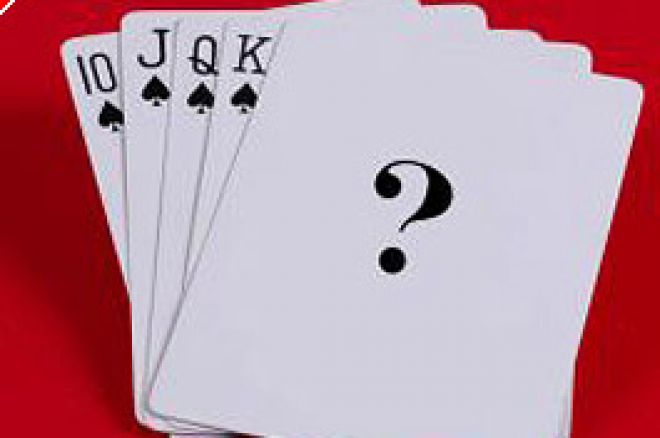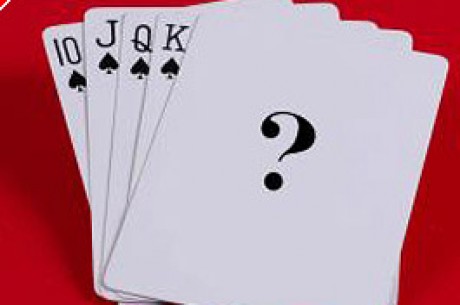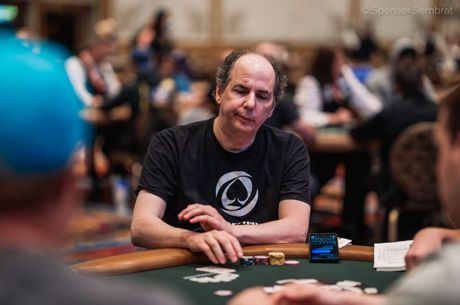Two Million Questions. Will Poker Answer?: Part Two

In our first article Two Million Questions, Part One, we discussed that approximately two million extra chips found their way into the 2006 World Series of Poker Championship Event. As the "extra chips" revelation swirled through the poker media and the internet, there were two schools of thought. One of the explanations was that the increase was due to normal chip accretion via chip race offs and dead stacks. The other school theorized that chips were introduced through either player treachery or staff error. In the next article, we will tackle the more nefarious arguments, examining the potential for organized cheating and supporting our own postulation that a serious staff error was made during the last chip color up in the Main Event.
For today, we will examine the plausibility of the "normal" explanations for the excess chips.
Was This "Normal"?
Could over two million extra chips have come from normal chip accretion? Knowing that this was a tournament of mammoth proportion, in both numbers and duration, many people feel intuitively comfortable with that explanation. We have even had Harrah's officials tell us recently that they too assumed normal tournament chip accretion was a reasonable explanation for the chip overage. But as we will see, this explanation doesn't hold water when simple math, the procedures, and chip count data are examined.
Dead Stacks:
In your local card room tournament, starting chip stacks are placed at available seats. If seats remain unoccupied, the "dead" stacks are blinded off and eventually removed from play, usually at the first break. There were no dead stacks in the Main Event of the WSOP. In fact, there were alternates seated each of the four Day Ones, which is how a room that seats only 2,080 players was able to accommodate 8,773 starters. No stack was blinded off unless the floor staff had verified with the registration desk that the seat had been paid for and assigned to a player. We witnessed this verification process on Day 1B and know this procedure was followed on all four Day Ones.
That being said, there was some evidence that a few stacks may have been blinded off in error. At least one player changed his starting day from Day 1A to Day 1C and through a clerical error he was still given a seat on Day 1A and his stack was completely blinded off. There are rumors that this may have happened more than once and that not all emergency cancellations and refunds were reflected in Harrah's registration database. But media who were in the tournament room did not report more than one empty seat in any of the four Day Ones and one of those players, Jennifer Leigh, actually showed up 5 ? hours late and played her stack. If we factor in this mostly anecdotal evidence and err on the conservative side, we could be persuaded that 50,000 extra chips may have been introduced in error via the registration process.
Race-Offs:
As the blinds and antes move up, lower denomination chips become obsolete and are removed from play. Most of these are "colored-up" or exchanged for an equal value of larger denomination chips. Since the color-up involves an equal exchange of value, no additional chips would be or, at least, should be introduced through the normal color-up process. During the course of play, however, many players end up with an odd number of lower denomination chips that don't equal the next largest chip denomination. These odd chips are "raced off" through a system whereby a random deal of one card to one chip is performed; in contention are the number of larger denomination chips equal in value to the total number of odd chips. The high cards receive the larger denomination chips. For a detailed explanation of the color-up and race-off process, go to the bottom of this article, or click (Color-Up And Race-Off Procedures) to go there now.
As tables break and players are moved, the distribution of lower denomination chips no longer adds up to a tidy sum, equally divisible by the next larger denomination chip. In cases of where there is not an equally divisible total of smaller denomination chips, sometimes the number of larger denomination chips is rounded up to the next highest number. In these cases, the table can exit a chip race off with a total chip count slightly higher than when they started. If this happened consistently throughout the tournament, across all the tables and all of the race-offs, could this account for two million extra chips?
Our first question was: Is it possible to reconstruct the entire twelve playing days of the Main Event from the various media reports to determine what would have been the maximum number of chips that could have been introduced via the race-off process? We determined with some simple math and a fair amount of reconstruction this was possible, so, we did.
The Math:
There are simple formulas for calculating the maximum value of chips added to a tournament during a race-off.
The maximum added chip value per table during a race-off is equal to the difference between one single lower denomination chip and the next value higher denomination chip. For instance, in the case of the $25 chip race-off, the maximum chip count added to each table would be the difference between a $100 chip and one single $25 chip; or $75 per table. To get the total chip value added to a tournament during a race-off, you multiply the maximum value added per table during a chip race-off times the number of tables remaining, which gives you the maximum number of total chips added to the tournament for each race-off.
The math is not difficult, but it is admittedly tedious. We encourage you to go through the detailed example of the Main Event $25 chip race off, as well as the step-by-step calculations for all five of the Main Event race-offs, by clicking (The Details and Math Behind the 2006 WSOP Main Event Race-Offs).
This Wasn't "Normal":
Our mathematical conclusion, detailed in the link above, is: the maximum chips that could possibly have been added to the 87,730,000 chip WSOP Main Event due to all of the race-offs was 84,850 chips.
Remember we have used the worst case, maximum increase that could have happened at any single table and applied that to each and every table at each and every race-off for the entire twelve playing days of the Main Event. And still, the absolute maximum increase that could have been introduced through the race-off system is 84,850 chips.
If we combine the potential blinding off of stacks in error and the maximum race-off chip accretion, we can account for less than a 140,000 chip increase. This is a far cry from two million and a most interesting number, considering the "official" chip overage at the beginning of the final table was 2,410,000 when compared to the suggested starting count of 87,730,000. By comparison, at the 2005 WSOP Main Event the final chip count was over its starting count by 0.16%. If we apply that same standard to the 2006 Championship, the overage would have been approximately, and coincidently, 140,500 chips.
We are confident that our analysis demonstrates that chip accumulation due to normal blinding off of dead stacks and chip race-offs can not explain the extra two million chips in play. But the "normal" argument loses even more explanatory power when you consider "when" the increase occurred. Using Harrah's unverified end-of day chip counts, there were 2.36 million more chips at the end of Day Seven than there were at the end of Day Five. The vast majority of chips were added sometime during Day Six and Day Seven. Dead stacks would have obviously all been blinded off at this point. There was only one chip color-up and race-off during this two day period: the color-up and race-off of the $5,000 chips on Day Seven. The most chips that could have been introduced normally in Day Seven's race-off was 15,000 see (math page below) for details. Something abnormal happened and all media coverage of the Main Event indicates that it happened within this two day window of play.
Not only have we narrowed the search for the "how" of the added chips, we have also narrowed the search for "when" the bulk of those chips had to have been introduced to the tournament. Read "Two Million Questions. Will Poker Answer?: Part Three" where player treachery and staff error at the WSOP Championship get their due diligence and we explain how and when the overwhelming majority of the extra chips were added to the Main Event.
Appendix A
<a name="Color-Up And Race-Off Procedures">Color-Up And Race-Off Procedures</a>
This is an explanation of the chip color-up and race-off general procedure. As you will see there are no consistent standards in the poker industry and therefore often local rules or floor decisions influence the actual process.
The Tournament Directors Association has the following rule #2:
When it is time to color-up chips, they will be raced off with a maximum of one chip going to any player. The chip race will always start in the No.1 seat. A player cannot be raced out of a tournament. In the event that a player has only one chip left, the regular race procedure will take place. If that player loses the race, he will be given one chip of the smallest denomination still in play.
Now this TDA rule presupposes that we know how to run a race-off and when and why.
From Roberts Rules of Poker, we have more but not complete information:
The lowest denomination of chip in play will be removed from the table when it is no longer needed in the blind or ante structure. All lower-denomination chips that are of sufficient quantity for a new chip will be changed up directly. The method for removal of odd chips is to deal one card to a player for each odd chip possessed. Cards are dealt clockwise starting with the 1-seat, with each player receiving all cards before any cards are dealt to the next player. The player with the highest card by suit gets enough odd chips to exchange for one new chip, the second-highest card gets to exchange for the next chip, and so forth, until all the lower-denomination chips are exchanged. A player may not be eliminated from the event by the chip-change process. If a player has no chips after the race has been held, he will be given a chip of the higher denomination before anyone else is awarded a chip. If an odd number of lower-denomination chips are left after this process, the player with the highest card remaining will receive a new chip if he has half or more of the quantity of lower-denomination chips needed, otherwise nothing.
There are a number of details that are not uniformly defined in the race-off process. For instance, technically a player cannot be raced-off out of a tournament, but usually that player is not given the first chip in a race-off. What does happen is if the player does not directly win a chip in the race-off, another chip is added and given to that player. Also, while it is a good rule to only add the final chip if the player "has half or more of the quantity of lower-denomination chips needed," more often than not the odd numbered chips are just rounded up and one extra chip is given at each table with a odd number of chips.
So, you see we are dealing with a process that is not uniformly codified or enforced. Tournament poker's popularity has resulted in the dramatic increase of player field size, the number of required tournament personnel, and the number of participating venues. An ambiguious or uncodified tournament process now translates to a higher potential and frequency of mistakes and misunderstandings, resulting in an uneven playing field for all participants.
For those who would like a complete example of a chip-up and race-off process, the following example covers a color-up (same as chip-up) and race-off for taking the $100 chips off of a table and replacing them with the $500 chip. Remember this process is done at each and every table in a tournament, usually at a break but as we will see below sometimes during live play.
There are ten players remaining. Each player stacks their black $100 chips out in front of them in stacks of five. Each stack is exchanged by the floor for a single $500 chip or two stacks for a $1,000 chip etc. Seats 1, 3, 5, 7, 9 each had black chips in multiples of 5 and therefore they are done with their chip-up and since they have no extra chips they are not involved in the race-off. Seat Two has 4 Black (100) chips, Seat Four has 2 Black chips, Seat Six has 1, Seat Eight has 3 chips, and Seat Ten has 3 Black chips. Notice there are a total of 13 Black $100 chips involved in the race-off. The dealer deals 4 cards face-up to Seat Two. The dealer then deals 2 cards to Seat Four, 1 card to Seat Six, 3 cards to Seat Eight, and 3 cards to Seat Ten.
The dealer then collects all Black chips and exchanges these (either from the table bank or more often from the floor person running the race-off) for 3 Red $500 chips. One chip for each 5 Black chips and an additional chip for the odd 3 chips. The highest card gets the first chip and that player's cards are mucked, as you may only win one chip in any race-off. Second and third chips go to the next two highest cards and the race-off is done and all of the $100 chips are off the table.
To facilitate the tournament as far as time goes, color-ups are generally done on a break. In fact, in larger tournaments the color-up is done after a round has ended but before the clock starts for the break. This allows players to stay and watch the process and assure its accuracy and then get a full break. Also, often 10 or 15 minutes before the color-up break, the floor staff will come around to each table and give the biggest stack a couple of racks and ask them to: "start buying up" the lowest denomination chips. This can usually be done without interfering with the final hands of a round and it facilitates the color-up by having most of the chips consolidated into the hands of one player, who can then have the chips color-up into large denomination chips. This is a convention that has developed in most tournaments but does lead to potential for large exchanges of chips between the floor staff and a single player at each table. Such a concentration of chips could mean that inadvertent mistakes would be magnified.
Appendix B
<a name="The Details and Math Behind the 2006 WSOP Main Event Race-Offs">The Details and Math Behind the 2006 WSOP Main Event Race-Offs</a>
What follows is a detailed review of the chip "Color-Up and Race-Off" (Cu&Ro) process for the 2006 WSOP Championship Event, specifically focusing on the maximum number of chips this process could have introduced throughout the event.
Why Color-Up and Race-Off?:
The basic reason for the Cu&Ro procedure is to remove small denomination chips from the tables when they are no longer needed for the minimum blinds and antes; and also to place larger denomination chips on the tables as the tournament structure increases. This was an especially important process for this year's Maine Event. Each of the 8,773 starters received a starting stack (20) of $25 chips, a stack (20) of $100, five $500 chips and five $1,000 chips (this was the make-up of each and every starting stack of $10,000.)
20 X $25 = $ 500
20 X $100 = $2000
5 X $500 = $2500
5 X $1000 = $5000
If all of those starting chips remained in play, the nine players at final table would have had over 438,000 chips of varying denominations, nearly 50,000 individual chips on average for each player, over 2400 stacks or 480 racks per player.
8,773 X 50 chips = 438,650 total chips in play
438,650/9 = 48,738 average chips per player
48,738/20 = 2,437 average stacks per player
2,437 stacks/5 = 480 average racks per player
You could cover the entire playing surface of a poker table with 480 racks stacked five high. Just the exercise of posting the $30K/$60K blinds using chips valued at $25, $100, $500 and $1,000 would have been a painstaking and slow exercise. The CU&RO procedure just simply makes the betting aspects of the game manageable.
The WSOP Chip Color-Up and Race-Offs:
Below is the blind and ante structure for the first nine rounds of the WSOP Main Event. From this structure, most players will recognize that the smallest chip on the tables at the beginning of this event would be the $25 denomination. Those $25 chips are needed through the first 8 rounds of play to pay the blinds ($25, $50, $150, $250) and the antes ($25, $50, $75).
ROUND BLINDS ANTE
1 $25 / $50
2 $50 / $100
3 $100 / $200
4 $100 / $200 $25
5 $150 / $300 $25
6 $200 / $400 $50
7 $250 / $500 $50
8 $300 / $600 $75
Chip Color-Up and Race-Off $25 chips
9 $400 / $800 $100
The first color-up and race-off occurred on Day Two, removing the $25 chips from play. Because there were two Day Twos and each day had staggered breaks with half of the field breaking at different times, the floor conducted four distinct color-up and race-offs of the $25 chips; one associated with each break period. Both Day Twos went through their color-up and race-offs of the $25 chips at approximately 5 PM.
Below is a detailed explanation of race-off process and calculation using the $25 chip race-off as an example. We have done the calculations for each of the five chip race-offs during the Main Event below..
$25 Race-Off Example:
In the case of the $25 chips, since four chips would be exchanged for a $100 chip, the race-off would involve only individual players with one, two or three chips remaining after they had exchanged all chips they held in multiples of four. The number of $100 chips a table would be competing for would be determined by the total value of chips in the race-off. For instance, if a table had twelve $25 chips in the race-off, or $300 total value in chips, they would ultimately be substituted for three $100 chips. In this case all the $25 chips are exchanged for an equal value of $100 chips and the total table chip count remains the same as it was before the race-off. But there are cases where a table can end up with a higher total chip count at the end of a race-off.
If the table had a total value of chips not equally divisible by $100 chips, they would race-off for the next highest number of $100 chips. For instance, tables that had thirteen, fourteen, or fifteen total $25 chips would be competing for four $100 chips. This rounding up procedure results in a table having a higher chip count at the end of a race-off than it did at the beginning. For instance, if a table had fifteen $25 chips in the race-off for a total value of $375, they would be substituted with four $100 chips at a value of $400; adding an extra $25 in chip count to the table. In the case of a table having thirteen $25 chips, or a value of $325, they would end up with $75 more in total table chip count at the end of the race-off. On each subsequent race-off of the $100, $500, $1,000 and $5,000 chips throughout the Main Event, additions to the total chip count could likewise occur.
The simple formula for calculating the maximum value of chips added to a tournament during a race-off is:
N= Value of Chip being raced off.
M= Value of next highest denomination Chip in play.
D= Difference in Value between M and N.
T= Tables in play.
M-N=D DxT= maximum chip increase during N race-off.
The maximum added chip value per table during a race-off is equal to the difference between one single lower denomination chip and the next value higher denomination chip. In the case of the $25 chip race-off, the maximum chip count added to each table would be the difference between a $100 chip and one single $25 chip; or $75 per table.
To get the total chip value added to a tournament during a race-off, you multiply the maximum value per table added per chip-race times the number of tables remaining, which gives you the maximum added chips for each race-off. In the case of the $25 chip, we would multiply $75 by the total number of tables remaining at the $25 race-off to get the maximum possible chip count introduced during that race-off. Using various media reports, we were able to determine that 210 tables were involved in the $25 race-off, including all four flights of Day One. Multiplying 210 by $75 results in a maximum of 15,750 chips introduced by $25 race off.
One $25 replaced by $100 = $75 increase X 210 tables = $15,750 maximum increase
Subsequent Race-Offs:
The next color-up and race-off was the substitution of the $100 chip with the next highest denomination chip, the $500 chip. Using the same logic as above, the maximum number of additional chips that could be introduced at each table would be 400 chips, or the difference between one single $100 chip and the larger denomination $500 chip. By the time this race-off took place there were 481 players remaining at 49 tables. Therefore, 49 X $400 = 19,600, or the maximum possible chip addition as a result of the $100 race-off.
One $100 replaced by $500 = $400 increase X 49 tables = $19,600 max. increase
At the $500 chip race-off, because there were $1,000 chips in play, the value of one $500 chip per table was the maximum that could be added. There were 288 players at 29 tables. So the math here is 29 X $500 = 14,500 possible chips.
One $500 replaced by $1000 = $500 increase X 29 tables = $14,500 max. increase
The $1,000 chip race-off could have resulted in a 4,000 chip increase per table. With 49 players remaining at 5 tables that means a 20,000 maximum chip increase was possible during the $1000 race-off.
One $1000 replaced by $5000 = $4000 increase X 5 tables = $20,000 max. increase
Finally we come to the $5,000 race-off. Since there were $10,000 chips in play, only the value of one extra $5K chip could be given per table and there were only 3 tables remaining for a worst case $15,000 chip increase.
One $5000 replaced by $10000 = $5000 increase X 3 tables = $15,000 max. increase
For the total maximum number of chips added to the 2006 WSOP Main Event, the simple math then is:
$15,750 + $19,600 + $14,500 + $20,000 + $15,000 = $84,850
No more then 84,850 chips maximum could have been added to the total 87,730,000 chips in play by way of the race-off procedure. And exactly and precisely zero chips should have been added through the chip-up process, which is an exact chip for chip exchange.








